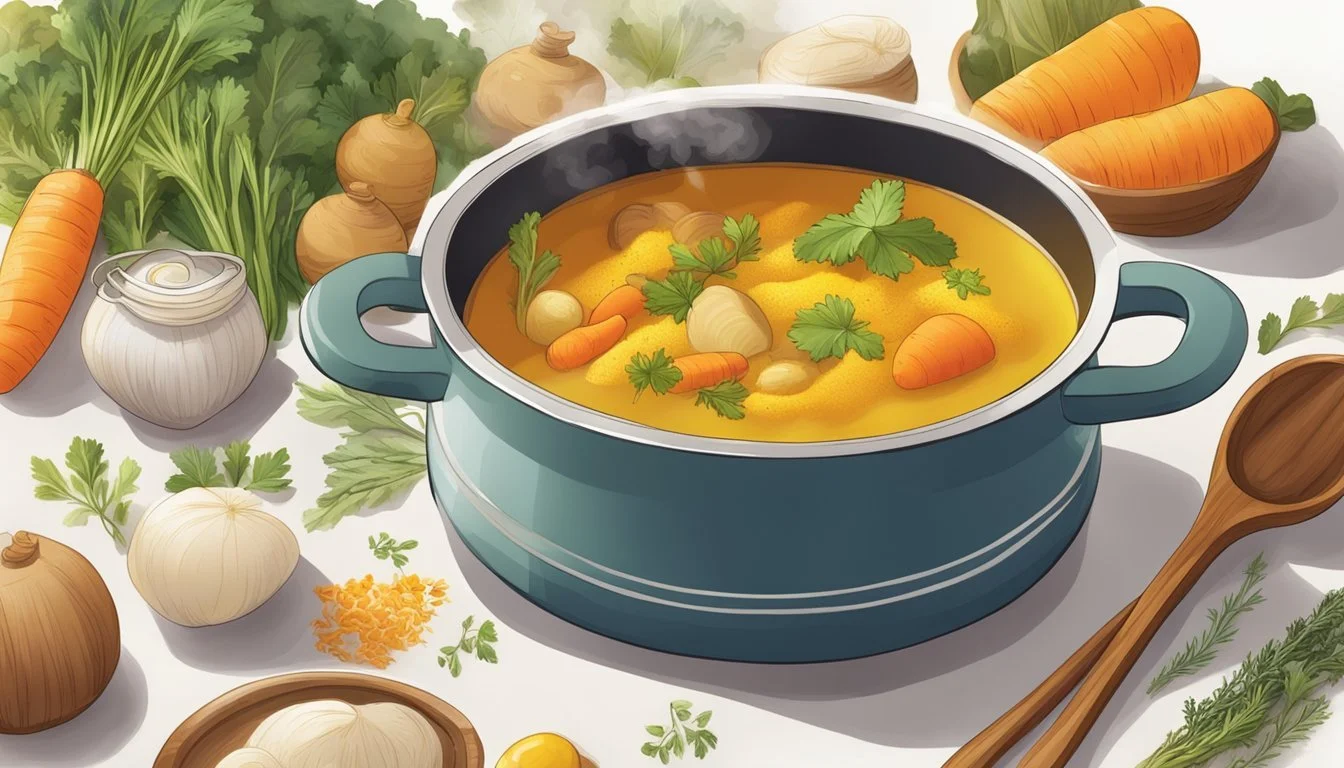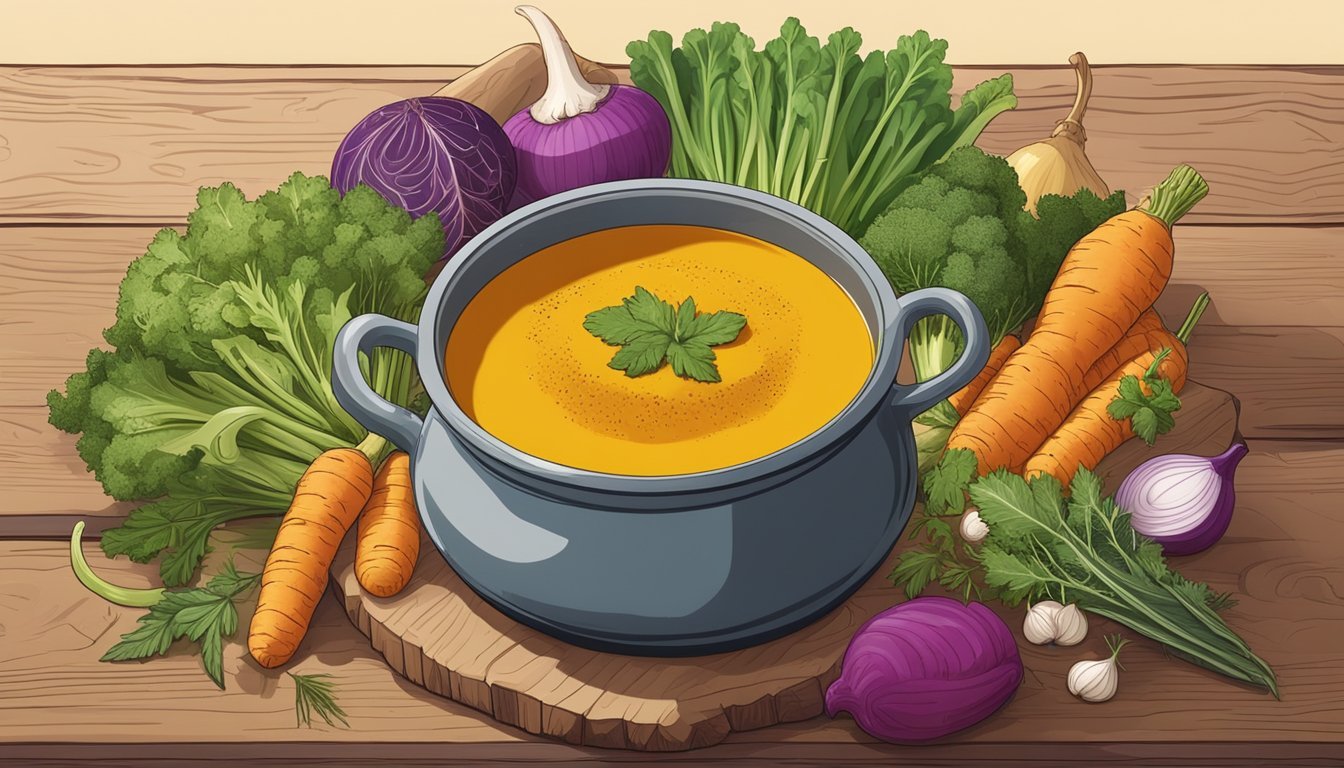Root Veggie Turmeric Soup Recipe
A Hearty Recipe for Health and Flavor
Discover > Healthy Living Through Food > Root Veggie Turmeric Soup: A Hearty Recipe for Health and Flavor
Root vegetables form the heart of many comfort dishes, celebrated for their earthy flavors and nutritional benefits. They offer a grounding base for a variety of recipes, and Root Veggie Turmeric Soup is a prime example of how these subterranean treasures can be transformed into a nourishing and warming meal. Featuring a harmonious blend of carrots, sweet potatoes, and parsnips, this soup is as vibrant in color as it is rich in vitamins and minerals.
The inclusion of turmeric not only provides the soup with its signature golden hue but also infuses it with a host of health benefits. This potent spice is widely recognized for its anti-inflammatory properties and its ability to boost the immune system. When simmered together with the root vegetables, it imparts a subtle earthiness that complements their natural sweetness.
Preparing Root Veggie Turmeric Soup involves a simple process that maximizes flavor while preserving the nutritional integrity of the ingredients. This dish is often enhanced with aromatics such as onions and garlic, as well as a variety of herbs and spices that round out the taste profile. The result is a comforting bowl of soup that supports well-being and satisfies the palate.
Health Benefits of Root Veggie Turmeric Soup
Root Veggie Turmeric Soup not only delivers a wealth of health benefits through its rich nutritional content and natural compounds but also provides a heartier meal option for those seeking a healthy and satisfying dinner. This healthy vegetable soup recipe is perfect for those looking to enjoy a light dinner.
The preparation is simple, requiring a Dutch oven to bring all the flavors together. Once ready, store any leftovers in a lidded container for convenient reheating. Serving up bowls of this delicious anti-inflammatory brothy vegetable soup not only nourishes the body but also makes for a comforting and satisfying meal, offering a perfect balance between a light dinner and a heartier, healthy meal.
Nutritional Value
Root vegetables are dense sources of fiber, essential for digestive health. They also pack a generous amount of vitamins, such as Vitamin A and Vitamin C, both crucial for maintaining eye health and skin integrity and supporting metabolic functions, respectively. Turmeric, the signature spice in this soup, adds not only a warm flavor but also nutritional benefits. Here's a quick look at the nutritional profile:
Fiber: Maintains gastrointestinal health
Vitamin A: Supports vision and immune function
Vitamin C: Facilitates growth and repair in body tissues
Antioxidants: Turmeric provides curcumin, a compound with antioxidant capabilities
Immune System Support
In the quest for a well-functioning immune system, a healing soup can play a crucial role in bolstering immune defenses. Root veggies, brimming with vitamins, and turmeric, with its immune-modulating compound curcumin, make this soup a nutritional powerhouse. To whip up this healthy vegetable soup recipe, you'll need a soup pot and a few simple recipes.
Start by sautéing the root veggies, then add cups of vegetable broth (how long does vegetable broth last?) or vegetable stock. The prep time is minimal, and soon you'll be using an immersion blender to create a hot soup that's not only delicious but also a healthy soup recipe that supports your immune system. Perfect for a comforting bowl during cold and flu season, this soup is a quick and easy way to nourish your body with wholesome goodness.
Vitamin C: Enhances white blood cell function
Antioxidants: Protect against oxidative stress
Anti-Inflammatory Properties
Chronic inflammation can be a precursor to numerous health issues. The anti-inflammatory nature of this soup comes from turmeric, which contains curcumin, known widely for its ability to reduce inflammation. Regular consumption of this soup might help in managing inflammation-related conditions.
Turmeric (Curcumin): Scientifically recognized for reducing markers of inflammation in the body
Healthy Soup: Overall, the ingredients work synergistically to reduce inflammation and promote health
Key Ingredients and Their Roles
The key ingredients of Root Veggie Turmeric Soup contribute to its rich flavor and health benefits. Each element is chosen for its specific taste and nutritional profile, ensuring a well-rounded and hearty dish.
Turmeric
Turmeric is the star ingredient, known for its vibrant yellow color and anti-inflammatory properties, primarily due to the active compound curcumin. A small amount of turmeric can significantly impact the color and flavor profile of the soup.
Root Vegetables
Root vegetables form the soup's foundation, providing texture, substance, and essential nutrients.
Carrots: Rich in beta-carotene for healthy skin and eyesight.
Potatoes: Offer a comforting creaminess and are high in potassium.
Sweet Potatoes: Bring a natural sweetness and are an excellent source of vitamin A.
Parsnips: Add a hint of spice and fibrous content.
Onion & Cloves (how long do cloves last?) Garlic: The aromatic base that imparts a depth of flavor and has immune-boosting properties.
Herbs and Spices
Herbs and spices not only infuse the soup with flavor but also offer their unique health benefits.
Ginger or fresh ginger: Complements turmeric in both flavor and health aspects, particularly aiding digestion.
Fresh Parsley and celery: Fresh herbs provide a pop of green and a subtle brightness to the soup.
Bay Leaf: A single bay leaf contributes a floral and slightly woodsy aroma.
Cumin: Adds earthiness to the dish.
Black Pepper: Enhances the bioavailability of curcumin, the active component in turmeric, making it more effective.
Recipe Guide
This guide provides precise instructions for creating a hearty Root Veggie Turmeric Soup. By following these steps, one can prepare, cook, and serve the soup efficiently while ensuring a flavorful and nutritious meal.
Preparation Steps
Ingredient Assembly:
Gather all necessary ingredients, ensuring you have root vegetables of your choice (such as carrots, sweet potatoes, and parsnips), turmeric, olive oil, sea salt (how long does sea salt last?), and lemon juice on hand.
Ensure there is a choice of broth available, be it vegetable broth or chicken stock.
Vegetable Prep:
Peel and dice your root vegetables into uniformly sized pieces to ensure even cooking.
Mince additional aromatics like garlic or ginger, if desired.
Spice Measurement:
Measure out the turmeric and any other spices you plan to use, according to your recipe's specifications or personal preference.
Cooking Procedure
Sautéing:
Heat olive oil in a large pot over medium heat.
Add the root vegetables and a pinch of sea salt, and sauté until they start to soften.
Simmering the Soup:
After the vegetables are softened, pour in your choice of broth, be it rich chicken stock or light vegetable broth.
Stir in the turmeric and bring the mixture to a gentle simmer, allowing the flavors to meld.
Blending (optional):
For a creamy soup, blend the mixture until smooth after it has been simmering for the requisite time. If using coconut milk, stir it in after blending.
Serving Suggestions
Finishing Touches:
Taste and adjust seasoning with sea salt or lemon juice as needed for an ideal balance of flavors.
Ladle the soup into bowls while hot.
Garnish:
Garnish with chopped parsley for a fresh element and an additional splash of olive oil for richness.
Customization Options
This section explores different ways that individuals can customize the Root Veggie Turmeric Soup to their dietary preferences or needs, whether it is to make it vegan, add more protein, or adhere to a low-FODMAP diet.
For instance, individuals can opt to use veggie stock instead of water to make a more flavorful broth or puree the soup for a smoother texture. Adding a pinch of salt while cooking or seasoning with salt to taste can enhance the flavor. Those who prefer milder flavors can reduce the amount of turmeric used, while others who enjoy strong flavors can add more.
Additionally, storing the soup in a lidded container can help preserve it for longer, making it a great option for colder months. Lastly, individuals can adjust the cook time for their desired consistency, and add cups of vegetable broth as needed to thin the soup.
Making It Vegan
To ensure the soup remains vegan, one simply needs to use vegetable broth instead of chicken bone broth and replace any cream with a dairy-free alternative, such as coconut milk. Olive oil can be used as a fat source to sauté vegetables, rather than butter or animal fats. This is also a great tip for making pureed soups (What wine goes well with soups?).
Protein Add-Ins
For those looking to increase protein intake, consider adding chicken or lentils (how long do lentils last?) to the soup. To keep the dish gluten-free and paleo-friendly, use chicken. Alternatively, for a vegan protein source, lentils work perfectly and also contribute to the heartiness of the soup.
Low-FODMAP Adaptations
Individuals following a low-FODMAP diet can make a few adjustments to enjoy this vegetable soup. First, one should select a low-FODMAP broth, such as chicken bone broth, and then ensure all vegetables used are within their dietary guidelines. For creaminess without high-FODMAP ingredients, one can incorporate lactose-free cream or coconut milk, which serve as excellent substitutes.
Dietary Considerations
When considering the Root Veggie Turmeric Soup, it is important to evaluate its nutritional aspects in terms of allergens, macronutrient content, and caloric value. This can help individuals align the soup with their dietary needs and restrictions.
Allergen Information
The soup is naturally gluten-free, and dairy-free, and can be considered suitable for a low-fodmap diet if certain high-fodmap vegetables are excluded. No known allergens are typically present unless it is modified to include allergen-containing ingredients such as barley (how long does barley last?) or milk.
Macronutrient Balance
This soup provides a balanced macronutrient profile that includes:
Carbohydrates: Root vegetables are rich in complex carbohydrates which provide a steady source of energy.
Fiber: A good source of dietary fiber, beneficial for digestive health.
Fat: Usually low in fat unless prepared with added oils or fats.
Protein: Typically low in protein; consider complementing with beans, lentils, or meat for a complete meal.
For those following a paleo diet, the soup can be adapted to exclude non-compliant ingredients such as legumes or grains.
Caloric Content
The caloric value can vary depending on the specific ingredients and quantities used. A standard serving may range from approximately:
Calories: 100-200
Carbohydrates: 20-30g
Sugar: Low
Fat: Low
Saturated Fat: Low
Sodium: Low
Fiber: 4-6g (Variable)
*Note: Sodium content can be controlled by the amount of salt added during preparation.
Calories, fats, and carbohydrates are given per standard serving and sugars are kept low unless sweetening agents are added. The high fiber content aids in satiety and supports digestion. Saturated fats and sodium can be minimized for heart health. The soup can be a warming, nutritious option for many dietary considerations.
Cooking Techniques
Mastering the cooking techniques of simmering and sautéing is essential for creating a flavorful Root Veggie Turmeric Soup. These methods will ensure that vegetables are cooked to the right texture and that spices release their maximum flavor.
How to Simmer Soup
Simmering is a gentle, slow cooking process critical for combining the flavors of the soup without overcooking the ingredients. To simmer the soup effectively, one needs to:
Bring to a boil: Start by bringing the soup to a boil.
Lower the heat: Reduce the heat to low, which should be just enough to maintain small bubbles rising to the surface.
Cook uncovered: Cook the soup uncovered for a prolonged period, stirring occasionally to prevent sticking.
The simmering step is paramount for infusing the turmeric and other spices into the broth, allowing their flavors to meld with the tender root vegetables.
Perfecting the Sauté
Sautéing the vegetables before adding them to the broth is crucial for depth of flavor. Here's how to perfect the sauté:
Heat the oil: Pour a generous amount of olive oil into a pan and heat it over medium heat.
Add the veggies: Once the olive oil is hot, add chopped root vegetables, cooking in batches if necessary to avoid overcrowding.
Stir frequently: Stir the vegetables frequently for even cooking and to prevent burning.
Sautéing not only enhances the taste but also helps to build a foundation of flavor for the soup. It's important to sauté until the vegetables are golden brown, which indicates they have caramelized slightly, adding a rich, savory note to the soup.
Storing and Reheating
Proper storage and reheating are crucial for maintaining the taste and safety of Root Veggie Turmeric Soup. Below are specific instructions to ensure that leftover soup retains its quality.
Refrigeration Tips
When refrigerating, cool the soup within two hours of cooking to prevent bacterial growth. It should be stored in an airtight container to preserve freshness and prevent absorbing other flavors from the refrigerator. The soup can be refrigerated for 3 to 4 days. Ensure that the refrigerator is at a constant temperature of 40°F (4°C) or below.
Freezing Guidelines
For longer storage, freezing is effective. Use freezer-safe containers or heavy-duty freezer bags, leaving an inch of space at the top as the soup will expand when frozen. Label the containers with the date of freezing; the soup can be kept frozen for 4 to 6 months for optimal quality. To thaw, transfer to the refrigerator overnight or use the microwave's defrost setting.
To reheat, transfer the refrigerated soup to a pot and warm it on the stove over medium heat until it reaches 165°F (74°C), stirring occasionally. If using a microwave, cover the soup with a microwave-safe lid or vented plastic wrap, and stir periodically for even heating.
Soup Pairings and Sides
Root Veggie Turmeric Soup is a warming and nourishing dish that can stand on its own, but it also pairs wonderfully with a variety of sides and salads. The right accompaniments can enhance the meal and make it more satisfying.
Complementary Salads
A fresh salad is the perfect counterbalance to the earthy richness of a vegetable soup. Ingredients like kale and spinach not only offer a crisp texture but also introduce a wealth of nutrients.
Kale Caesar Salad:
Kale, thinly sliced
Caesar dressing, lightly tossed
Croutons (how long do croutons last?), for added crunch
Parmesan shavings, to taste
Spinach and Quinoa Salad:
Baby spinach leaves, fresh
Cooked quinoa (how long does cooked quinoa last?), cooled
Cherry tomatoes, halved
Olive oil and lemon vinaigrette
These salads provide a protein boost through additions like quinoa and parmesan, and their vibrant dressings will complement the soup without overpowering it.
Matching Breads
The bread serves as a hearty companion to any soup, capable of transforming the meal into something truly filling. Root Veggie Turmeric Soup pairs especially well with breads that have a robust texture or a subtle sweetness to them.
Crusty Whole Wheat Bread:
Offers a firm texture that holds up to dipping
The nutty flavor complements the turmeric's warmth
Honey Oat Bread:
The sweetness contrasts the soup's savory notes
Oats (how long do oats last?) on the crust add a satisfying texture
Whether one opts for a slice of whole wheat to soak up the soup or a piece of honey oat bread to dab at the edges of the bowl, bread is an excellent addition. It provides both satiety and a tactile, taste-enhancing experience.
Seasonal and Occasional Guidance
Root Veggie Turmeric Soup serves as a comforting dish during the cold season, providing both warmth and nutritional benefits.
Winter Warmers
In winter months, the desire for warmth and comfort can be met with hearty, healthy soups. Root Veggie Turmeric Soup stands out as a particularly wise choice due to its thermal properties and dense nutrients. This soup incorporates root vegetables, which are in peak season during winter, ensuring maximum flavor and freshness.
Root Vegetables: Carrots, parsnips, and sweet potatoes
Warm Spices: Turmeric, ginger, and cinnamon
These ingredients not only impart deep flavors but also contribute to the body's overall warmth.
Cold and Flu Remedies
During cold and flu season, maintaining a strong immunity is vital. A bowl of Root Veggie Turmeric Soup can support this goal, offering an array of immunity-boosting ingredients. The inclusion of turmeric, known for its anti-inflammatory properties, can be particularly beneficial.
Turmeric:
Benefit: Anti-inflammatory
Ginger:
Benefit: Antioxidant
Garlic:
Benefit: Antiviral
Root Vegetables:
Benefit: Vitamins & Minerals Boost
These components aim to aid in fending off sickness and facilitating a quicker recovery when one falls ill. The soup's nutritious base is not only restorative but may also play a preventative role during peak sickness periods.
Social Media and Community
In the age of social media, sharing and engaging with content around Root Veggie Turmeric Soup has created a vibrant online community of health-conscious individuals and cooking enthusiasts.
Sharing on Instagram
Instagram has become a pivotal platform for food lovers to showcase their Root Veggie Turmeric Soup creations. Home cooks are using hashtags like #RootVeggieSoup and #TurmericRecipes to share vibrant images of their homemade dishes, often gaining inspiration from a variety of cookbooks and online sources. Accounts dedicated to healthy cooking exhibit their soup's rich, golden hue, attributing their success to detailed recipes.
Community Recipes
A plethora of community-driven recipes for Root Veggie Turmeric Soup can be found online, where food bloggers and amateur chefs post their takes on this wholesome dish. Individuals often:
Share their unique variations on recipe websites
Offer tips for the best ingredient combinations
Provide feedback on how well certain adaptations worked in their kitchens
This engagement not only enriches the community but also helps to refine and enhance the recipes over time, as it allows for a continuous exchange of ideas and techniques.
Addresses Common Health Concerns
Root Veggie Turmeric Soup is packed with health benefits that can play a role in managing various health concerns. It focuses on anti-inflammatory properties and is abundant in nutrients crucial for overall well-being.
Digestive Health
This soup provides a rich source of dietary fiber from root vegetables, facilitating improved digestive function. It contains turmeric, which has been shown to support digestion and alleviate symptoms of bloating and gas. Additionally, the soup's warm broth aids in hydrating the digestive tract, which is essential for proper digestion.
Chronic Disease Management
The ingredients in Root Veggie Turmeric Soup are associated with the management of chronic diseases such as heart disease, arthritis, and some forms of cancer.
Heart Disease: Root vegetables in the soup are low in fat and high in potassium, helping to regulate blood pressure and maintain heart health.
Arthritis: Turmeric contains curcumin, a compound with strong anti-inflammatory effects, which may reduce symptoms of arthritis.
Cancer: Some studies suggest that a diet rich in anti-inflammatory foods like turmeric may lower the risk of certain types of cancer
Through its nutritional composition, the soup may contribute to a balanced diet and support disease management strategies.










